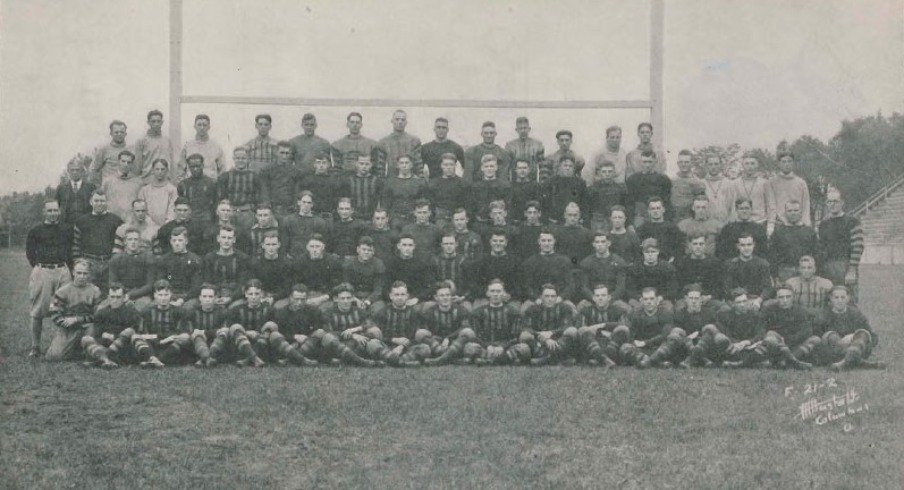With over 130 football seasons under its belt, Ohio State's program boasts an undeniably rich history.
While not every season can be considered elite, each team has its own story to tell.
Today we look back 100 years to the 1921 season, with notable storylines ranging from program-changing to dubious.
Coming off a 7-0 run to a conference crown before taking a 28-0 hit from California in the Rose Bowl, head coach John Wilce entered the 1921 season without star halfback Pete Stinchcomb and quarterback "Hoge" Workman, among others, but the cupboard was far from bare.
The 1921 campaign also served as Ohio State's last at Ohio Field as construction on Ohio Stadium commenced in August, with the 1922 Buckeyes set to play in the newly mined Horseshoe.
The Buckeyes called Ohio Field home from 1898 through the 1921 season and the venue located at the corner of Woodruff Avenue and High Street underwent numerous changes during its 24-year run.
In the early days, Ohio Field boasted a modest 500 seats and would grow to some 14,000 but as Ohio State's gridiron popularity swelled, with sometimes 20,000 surrounding the field and another 20,000 watching from further out, a replacement venue was long overdue. In fact, by 1919, old articles from the period note surrounding businesses and homeowners erected rooftop seating and charged admission for a glimpse of the action, particularly as Chic Harley donned the scarlet and gray.
In the '21 season opener, Wilce's squad handled Ohio Wesleyan, 28-0, in Columbus but that was quickly forgotten the following Saturday as the Buckeyes fell to Oberlin, 7-6, also at Ohio Field.
Uninspired and leading just 6-0 in the third quarter, Ohio State allowed Oberlin to drive 85 yards for what turned out the be the game-winning touchdown. The loss to the in-state foe still serves as the last such event, now 100 years later. I guess it's worth a footnote the Buckeyes didn't play an in-state opponent from 1933-1991 but you get the idea - it was a colossal upset.
Ohio State football historian Jack Park wrote that Wilce, unimpressed with his team's effort, crushed his squad with late practices the following week. Apparently in receipt of Wilce's message, the underdog Buckeyes put a 27-0 beating on Minnesota, also at Ohio Field.
With its mojo back intact, Ohio State beat Michigan the following week, 14-0, in front of 45,000 fans in Ann Arbor's Ferry Field. The win served as Ohio State's third-straight against the Wolverines and spoiled not only homecoming but also Michigan's dedication of the field, commemorating its expansion from 25,000 to 45,000 seats.
Wins at Chicago (7-0) and at home versus Purdue (28-0) set the stage for the season finale, and therefore the last football game at Ohio Field, against Illinois.
Sitting at 4-0 in league play, having punished Ohio Wesleyan, Minnesota, Michigan and Purdue by a combined score of 76-0, the Buckeyes were a heavy favorite against a 2-4 Illini squad winless in conference action.
Wilce's team dominated the afternoon's stat sheet but went scoreless in three trips to the red zone. Meanwhile, Illinois scored the game's lone touchdown on a fluke play in which a pass deflected off the chest of OSU defender Cyril "Truck" Myers before it was secured by Laurie Walquist who then waltzed into the end zone to secure the 7-0 victory.
An interesting anecdote from the loss came as the Chicago Tribune's Harvey Woodruff, impressed by the Illini's ability to pull the upset while playing only 11 guys, referred to them as the "Fighting Illini" in his recap for the paper. Of course, the moniker proved sticky.
With the disappointing loss Ohio State finished the season with a 5-2 mark despite outscoring opponents 110-14.
Iolas Huffman and Myers were the team's most notable players.
Huffman, following a first-team All-American nod in 1920, repeated the honors in '21 as a dominant defensive lineman. On campus originally to play baseball, where he earned three varsity letters for the Buckeyes, Huffman had never played football until he walked by an Ohio State practice and decided to try out. The Chandlersville, Ohio product was a kick-blocking specialist and an iron man of sorts, missing just one quarter of action across four seasons for the Buckeyes. He went on to play two NFL seasons.
Myers, out of Bucyrus, Ohio, captained the '21 team and also earned first-team All-American honors. A force from his end spot, Myers helped anchor the Buckeyes' dominant defense and was a threat as a receiver on offense.
Case in point, probably his biggest play in an Ohio State uniform came the year prior when, against Illinois with a Rose Bowl bid on the line, Myers got behind the defense for a touchdown catch on the last play of the game in a 7-0 win for the good guys.
Wilce would go on to coach seven more seasons for the Buckeyes but never finished higher than third in the conference standings (1926), going 7-1 overall that season.


